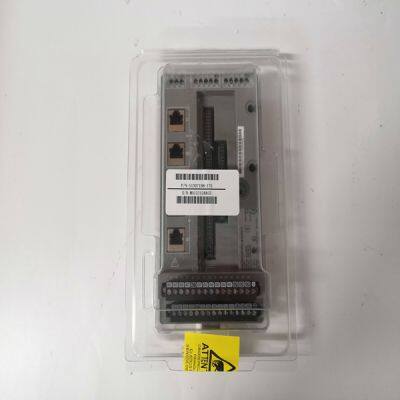
SC-UCMX01 51307198-175
Product Details
Product Details
Product Description
Product DescriptionBrand:Honeywell
Type:SC-UCMX01 51307198-175
Origin: the United States
Warranty: 365 days
Colour: new/used
Shipping method: Courier delivery
Module of PLC, DCS, ESD system card, the card is a vibration monitoring system, steam turbine control system module, the advantages of the gas generator spare parts brand: Allen Bradley, BentlyNevada, ABB, Emerson Ovation, Honeywell DCS, Rockwell ICS Triplex, FOXBORO, Schneider PLC, GE Fanuc, Motorola, HIMA, TRICONEX, Prosoft etc. Various kinds of imported industrial parts
Our main products are widely used in metallurgy, petroleum, glass, aluminum manufacturing, petrochemical industry, coal mine, papermaking, printing, textile printing and dyeing, mechanical, electronic manufacturing, automobile manufacturing, plastic machinery, electric power, water conservancy, water treatment/environmental protection, boiler heating, energy, power transmission and distribution and so on.
Remote Speed Setpoint One of the 4–20 mA inputs can be configured to remotely adjust the speed setpoint. Typically, a process control external to the 505E interfaces with this input to regulate the turbine’s speed or load to control a related process. The remote speed setpoint input directly affects the 505E’s speed setpoint. The maximum rate at which the remote input signal can change the speed setpoint is programmable. When the remote setpoint is enabled, the speed setpoint will move at a much slower rate until the two settings are matched, at which time the speed setpoint will be allowed to move at the maximum rate. The remote speed function can be enabled and disabled as required from the front-panel keypad, remote contact inputs or the communication line. Auxiliary Control The Auxiliary control channel can be used to either control a parameter or limit a parameter. The Auxiliary PID controller can be used to control or limit unit load/power, plant import/export levels, inlet pressure, exhaust pressure, temperature or any other process directly related to turbine load. The Auxiliary input is a 4–20 mA current signal. The Auxiliary PID control amplifier compares this input signal with a setpoint to produce a control output to the digital LSS (low-signal select) bus. The LSS bus sends the lowest signal to the ratio/limiter logic which determines HP and LP valve positions. The Auxiliary control amplifier can also receive a programmable (optional) droop feedback signal to increase system stability. This is a direct feedback using a portion of the Auxiliary control amplifier output. The Auxiliary setpoint is adjustable with raise or lower commands through the keypad on the front of the control, through remote contact inputs or through the communication links. Also, the setpoint can be directly set by entering the new setpoint from the keypad or through Modbus. In addition, an analog input can be programmed to remotely position the Auxiliary setpoint.
Remote Aux Setpoint One of the 4–20 mA inputs can be configured to remotely adjust the Auxiliary setpoint. The remote aux setpoint input directly affects the auxiliary setpoint. The maximum rate at which the remote input signal can change the auxiliary setpoint is programmable. When the remote setpoint is enabled, the auxiliary setpoint will move at a much slower rate until the two settings are matched at which time the setpoint will be allowed to move at the maximum rate. The remote aux function can be enabled and disabled as required from the front panel keypad, the remote contact inputs, or the communication links.
>> Discount Cowtotal Factory Universal Auto Car Electric Fuel Pump for Toyota Corolla Noah Innova Hyundai Nissan Mitsubishi Pajero Chevrolet Mazda3 Suzuki
>> JIMBO smart 20 guns metal digital storage fire resistant gun safe cabinet
>> 50 Meters Dental Floss Nylon Floss Waxed with Mint Flavor Customized
>> St-747e Direct Drive Motor Overlock Industrial Sewing Machine Textile Machine
>> High Quality Biomass Comprehensive Crusher, China Alva Woodworking Machinery, Wood Chipper
>> Office Small Automatic 2 Roller Adjustable 220mm Width Photo A4 Hot Cold Laminator Laminating Machine
>> Professional Good Metal 3D Printer Fdm Desktop 3D Printer Kit Filament Machine Fdm Impresora 3D for Indusrial
>> 4716888, 101644050, 052976074 Angle Sensor for Hitachi Ex100-2/100-3/120-2/120-3/200-2/200-3/220-2/220-3/400LC-5/550/550-3/550LC Excavator
>> High quality Asphalt Cleveland Open Cup Flash Point Tester hot sale
>> China Vertical CNC Turning Machine CNC Vertical Lathe Machine Price
>> Hot Melt Glue Machine Accessories Part Compatible with Robatech Nozzle 37210
>> Soft Nylon Material Tricot Tulle Warp Knitted Wedding
>> 48V 200ah LiFePO4 Lithium Iron Phosphate Battery 48V Lithium Battery
>> Non-metallic Ultrasonic Detector of building foundation piles by cross-hole sonic logging
>> 520L CE ROHS Approval Large Capacity Frost Free Side By Side Excellence Refrigerator
>> 94% Sodium Tripolyphosphate STPP with Factory Price
>> Leading Manufacturer of High Quality Luxury Women Genuine Leather Hobo Bag
>> 8 Even Spell Oak Chevron Engineered Flooring
>> new arrival skmei 9221 zinc alloy case automatic watches mechanical watches men
>> Motorcycle Knee Pads Elbow Guards
>> CNC Cutting Turning Tool Holder Sducr/Sducl External Toolholder for Dcmt Carbide Insert
>> Heater Water for Flat Panel Pump Glass Mini Paint Plate Air Low Iron Vacuum Tubes Home Stainless Steel Thailand Solar Collector
>> Face Tissue Paper Packaging Machine
>> Aol CNC Oscillating Knife Car Sticker Paperboard Cardboard Box Cutting Machine Lectra Label Printing Machines Price
>> Sialwings High Visible Pullover Fluorescent Safety Hoodie For Men Hi Vis Winter Work Clothing
>> Ultrafine Powder Grinding Machine Spiral Jet Mill 2-45 Um for Cosmetic
>> New Design Cheap Inflatable Stand up Paddle Sup Board Isup
>> Trap Wild Pig / Cage Hog Pig Traps Type for Wild Pigs
>> Simple Operation Automatic Template Motif Rhinestone Brush Shaking Machine
>> KW-520C PU Door Gasket Foaming Machine